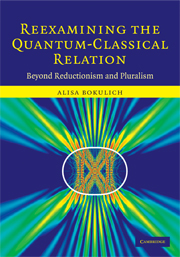Book contents
- Frontmatter
- Contents
- Acknowledgements
- Introduction
- 1 Intertheoretic relations: Are imperialism and isolationism our only options?
- 2 Heisenberg's closed theories and pluralistic realism
- 3 Dirac's open theories and the reciprocal correspondence principle
- 4 Bohr's generalization of classical mechanics
- 5 Semiclassical mechanics: Putting quantum flesh on classical bones
- 6 Can classical structures explain quantum phenomena?
- 7 A structural approach to intertheoretic relations
- References
- Index
2 - Heisenberg's closed theories and pluralistic realism
Published online by Cambridge University Press: 04 August 2010
- Frontmatter
- Contents
- Acknowledgements
- Introduction
- 1 Intertheoretic relations: Are imperialism and isolationism our only options?
- 2 Heisenberg's closed theories and pluralistic realism
- 3 Dirac's open theories and the reciprocal correspondence principle
- 4 Bohr's generalization of classical mechanics
- 5 Semiclassical mechanics: Putting quantum flesh on classical bones
- 6 Can classical structures explain quantum phenomena?
- 7 A structural approach to intertheoretic relations
- References
- Index
Summary
I could be bounded in a nutshell, and count myself a king of infinite space.
Shakespeare, Hamlet, Act 2 Scene 2Introduction
As we saw in the last chapter, the received account of the relation between classical and quantum mechanics is a form of reductionism, where classical mechanics is supposed to emerge from quantum mechanics in the limit of some parameter. When we examine more closely the views of three of the key founders of quantum theory, however, we see that none of them took the relation between these theories to be adequately captured by such a reductionist limit. Indeed as we shall see presently, Werner Heisenberg's account of the relation between classical and quantum mechanics is actually a strong form of theoretical pluralism, quite similar to Nancy Cartwright's metaphysical nomological pluralism introduced in Section 1.3. Rather than viewing quantum mechanics as the fundamental theory that replaced classical mechanics, Heisenberg argues that both theories are required, each having its own proper domain of applicability and each being a perfectly accurate and final description of that domain.
Throughout his career, Heisenberg held a highly original view in the philosophy of science, centered on his notion of a closed theory. Very briefly, a closed theory is a tightly knit system of axioms, definitions, and laws that provides a perfectly accurate and final description of a certain limited domain of phenomena. This notion has profound implications for Heisenberg's understanding of scientific methodology, theory change, intertheoretic relations, and realism.
- Type
- Chapter
- Information
- Reexamining the Quantum-Classical RelationBeyond Reductionism and Pluralism, pp. 29 - 48Publisher: Cambridge University PressPrint publication year: 2008



